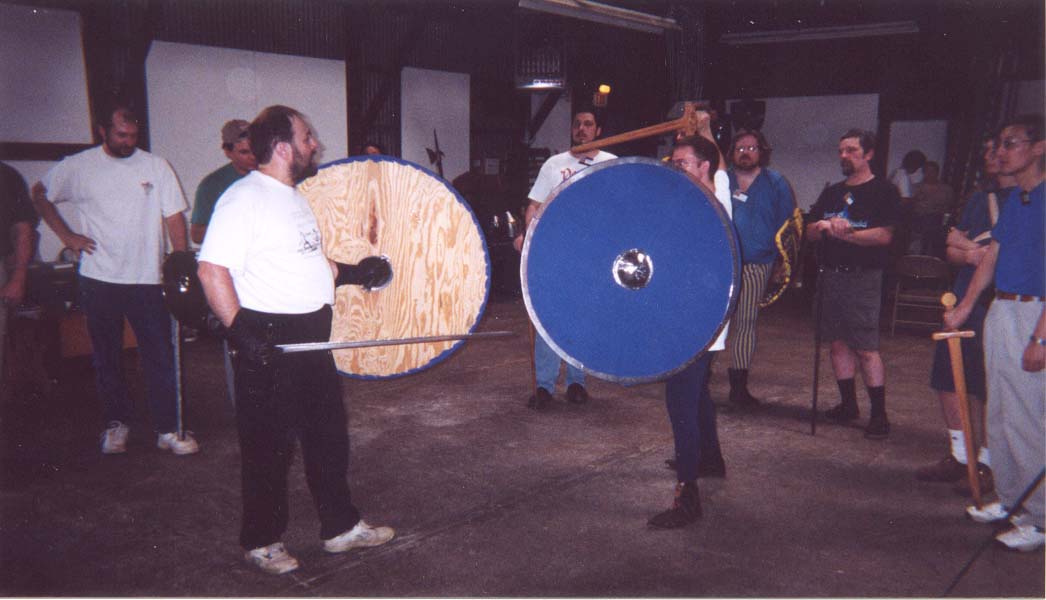Tasmanian Academy of Swordsmanship History
The origins of the Tasmanian Academy of Swordsmanship date back to the early 1980s when founder Stephen Hand first discovered that there were surviving manuals teaching the European Martial Arts of the 14th-19th centuries. Stephen’s initial forays into applying historical teachings to re-enactment combat did not bear much fruit. It was not until Stephen moved from Tasmania to Sydney in 1989 and discovered a group of re-enactors who had been exploring the same sources, that things started to get serious. Stephen joined with Andrew Brew and David Green in the Pike and Musket Society where they explored 17th century rapier fencing.
At around the same time Stephen and Peter Radvan, another long-term re-enactor, decided to start teaching the sword system of George Silver to medieval re-enactors. Little was known of medieval fencing sources at this time and it was reasoned that a real system of swordsmanship, albeit separated in time by several centuries from the period being re-enacted, was likely to be closer to what medieval people did than the made-up styles then being used in re-enactment. The fact that the real systems were also far more effective than the made-up ones helped to convince many people of this approach.
In 1998 Stephen, Andrew and Peter concluded that their study of historical swordsmanship had gone beyond an adjunct to historical re-enactment and they formed one of Australia’s first Historical European Martial Art (HEMA) groups.
The origins of the Tasmanian Academy of Swordsmanship date back to the early 1980s when founder Stephen Hand first discovered that there were surviving manuals teaching the European Martial Arts of the 14th-19th centuries. Stephen’s initial forays into applying historical teachings to re-enactment combat did not bear much fruit. It was not until Stephen moved from Tasmania to Sydney in 1989 and discovered a group of re-enactors who had been exploring the same sources, that things started to get serious. Stephen joined with Andrew Brew and David Green in the Pike and Musket Society where they explored 17th century rapier fencing.
At around the same time Stephen and Peter Radvan, another long-term re-enactor, decided to start teaching the sword system of George Silver to medieval re-enactors. Little was known of medieval fencing sources at this time and it was reasoned that a real system of swordsmanship, albeit separated in time by several centuries from the period being re-enacted, was likely to be closer to what medieval people did than the made-up styles then being used in re-enactment. The fact that the real systems were also far more effective than the made-up ones helped to convince many people of this approach.
In 1998 Stephen, Andrew and Peter concluded that their study of historical swordsmanship had gone beyond an adjunct to historical re-enactment and they formed one of Australia’s first Historical European Martial Art (HEMA) groups.
May 2000 saw Australia become part of the wider international HEMA community. Stephen Hand was invited to teach at the first two international historical fencing conferences. These were held within two weeks of each other (deliberately, to allow overseas instructors to attend both) in Lansing, Michigan and Houston, Texas, both in the USA. Stephen presented the fencing systems of 16th century authors George Silver and Vincentio Saviolo at both events, where he met and fenced with many of the early pioneers of historical fencing. Also during this trip Stephen gave a lecture at the Higgins Armory, in Worcester Massachusetts, one of the largest collections of Medieval and renaissance arms and armour in the world.
In 2001 Stephen returned to the US where, in the absent shadow of the recently collapsed World Trade Centres he became the first Australian to win an overseas tournament, winning the Western Martial Arts Workshop’s rapier fencing tournament against a field of over 60 competitors, from five different countries.
In 2003 Stephen became joint author, alongside Paul Wagner, of one of the earliest HEMA books, Medieval Sword and Shield, an examination of the world’s oldest fencing manual, Royal Armouries Manuscript I.33. He also edited and contributed to SPADA, a collection of peer reviewed papers on aspects of HEMA.
In 2004 Stephen returned to Hobart and set up a club branch. In 2005 a second edition of SPADA was released, again edited by Stephen and in 2006 Stephen released English Swordsmanship, a comprehensive analysis of the sword system of George Silver.
In 2012 Stephen was contacted by Matthew Boyd, a long-term martial artist from Longford, who had been studying English Swordsmanship for some years. Matthew came to Hobart to take classes from Stephen, and in 2015 opened a branch in Launceston. In 2018 Matthew successfully played his Provost’s prize, becoming the second fully qualified instructor in Tasmania.
A third Tasmanian branch, on King Island was started in 2022 by Shaun Douglas, a senior student of Stephen’s for many years. Shaun is currently ranked as a Free Scholar, the most senior non-teaching rank, and is working towards his Provost’s certification, mentored by Stephen and Matthew.
Stephen and Matthew are ably assisted by some excellent senior students who act as Ushers, a historical term for assistant instructors. Nita Kitto, Lewis Hand and Bennet McComish act as Ushers in Hobart and Joseph Gora in Launceston.
In 2018 Stephen published a new book, Swordplay in the Age of Shakespeare, examining the fencing systems of the four authors whose works were published in England during Shakespeare’s career, Giacomo Di Grassi, Vincentio Saviolo, George Silver and Joseph Swetnam. In the last few years he has been a contributor to a series of essay collections titled Meditations on HEMA as well as writing a massive paper debating the true nature of George Silver’s system of swordsmanship.
In June 2025 the instructors and students in the three Tasmanian groups made the decision to create a separate Tasmanian HEMA group, founding the Tasmanian Academy of Swordsmanship.



